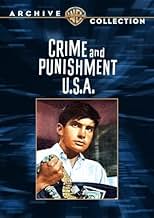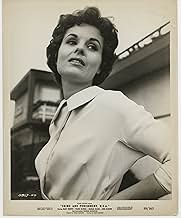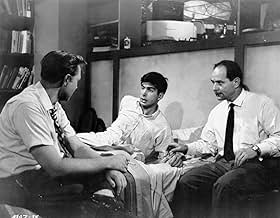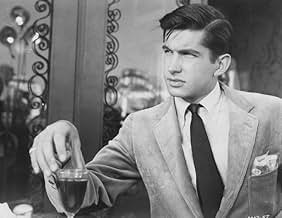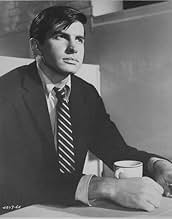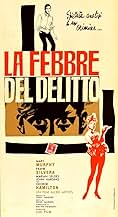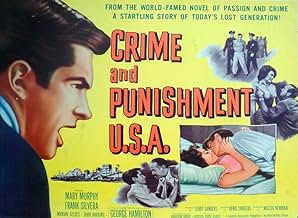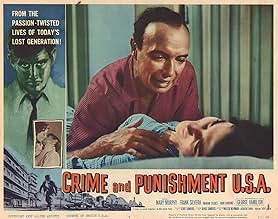A Californian law student murders a pawnbroker, then matches wits with the detective on the case.A Californian law student murders a pawnbroker, then matches wits with the detective on the case.A Californian law student murders a pawnbroker, then matches wits with the detective on the case.
- Director
- Writers
- Stars
- Nominated for 1 BAFTA Award
- 2 wins & 1 nomination total
Tony Johnson
- Mrs. Cole
- (as Toni Merrill)
Sidney Clute
- Doctor
- (as Sid Clute)
James Hyland
- Man in Coffee Shop
- (as Jim Hyland)
- Director
- Writers
- All cast & crew
- Production, box office & more at IMDbPro
Featured reviews
A young man murders an old woman for money, then relies on a sense of intellectual superiority to defeat an investigating detective.
A heavyweight subject like Dostoevski would be a challenge for the most experienced filmmaker. For the youthful crew here, however, it proves way too much. For one, Hamilton simply doesn't have the gravitas to bring off a convincing intellectual heavyweight, and that punches a hole right through the film's middle. But he's not the only one. Silvera's cagey detective makes those cat and mouse sessions with Robert (Hamilton) borderline parody. I don't know what director Sanders was telling him, but whatever it was, it didn't work. Ditto Harding's hammy wife killer that produces another regrettable result. Unfortunately, acting here means more than usual since there's so much loaded conversation. Only the two women, Murphy and Seldes, come off aptly.
On the other hand, the filmmakers certainly don't lack imagination. Adapting a bleak 19th- century Russian novel to the sunny climes of LA amounts to an imaginative undertaking, whatever the outcome. However, modifying a dense 1,000-page novel into a 70-minute screenplay would be a challenge for Dostoevski himself. Unfortunately, the effort here is like trying to pack 10 lbs. of weighty story into a 5 lb. leaky screenplay. All in all, I'm glad the Sanders brothers and Hamilton went on to more appropriate projects.
A heavyweight subject like Dostoevski would be a challenge for the most experienced filmmaker. For the youthful crew here, however, it proves way too much. For one, Hamilton simply doesn't have the gravitas to bring off a convincing intellectual heavyweight, and that punches a hole right through the film's middle. But he's not the only one. Silvera's cagey detective makes those cat and mouse sessions with Robert (Hamilton) borderline parody. I don't know what director Sanders was telling him, but whatever it was, it didn't work. Ditto Harding's hammy wife killer that produces another regrettable result. Unfortunately, acting here means more than usual since there's so much loaded conversation. Only the two women, Murphy and Seldes, come off aptly.
On the other hand, the filmmakers certainly don't lack imagination. Adapting a bleak 19th- century Russian novel to the sunny climes of LA amounts to an imaginative undertaking, whatever the outcome. However, modifying a dense 1,000-page novel into a 70-minute screenplay would be a challenge for Dostoevski himself. Unfortunately, the effort here is like trying to pack 10 lbs. of weighty story into a 5 lb. leaky screenplay. All in all, I'm glad the Sanders brothers and Hamilton went on to more appropriate projects.
In California, Robert Cole (George Hamilton) collapses in front of the cops. He buries the evidence of his crime, but a dying man may have seen him. He takes the man back home to Sally. He had written an article stating that certain superior people can break the law which comes to the notice of the police. He is brought in for an interview.
This opens on Pacific Ocean Park in Santa Monica. The most fascinating part of this B-crime movie may be the locations. It's great to see the old California with all the oil rigs. It does have a young George Hamilton as the lead. He's fine, but he's never been a great actor. I wanted this to start as a darker noir crime thriller. Robert should leave the man to die on the side of the road. That's the darker start. It's interesting that Robert has his views. Otherwise, the plot drags and I don't really care about him. This is not as compelling as it should be.
This opens on Pacific Ocean Park in Santa Monica. The most fascinating part of this B-crime movie may be the locations. It's great to see the old California with all the oil rigs. It does have a young George Hamilton as the lead. He's fine, but he's never been a great actor. I wanted this to start as a darker noir crime thriller. Robert should leave the man to die on the side of the road. That's the darker start. It's interesting that Robert has his views. Otherwise, the plot drags and I don't really care about him. This is not as compelling as it should be.
George Hamilton stars with Marian Seldes and Mary Murphy in "Crime and Punishment USA," an adaptation of the novel by Dostoevsky, directed by Denis Sanders.
The film "introduces" George Hamilton.
Hamilton plays a young man who kills and robs a pawnbroker and later comes up against a smart police detective (Frank Silvera) who preys on his conscience.
The only other version of this I've seen is the Peter Lorre one from 1935 and as you might guess, this film doesn't compare, and comparing George Hamilton to Peter Lorre - well, it can't be done.
One thing both films have in common is that they were done cheaply, and both in black and white. The black and white serves both films very well. It made the places in this film look kind of low-class and gritty.
The atmosphere was really the only thing I liked. The music was very loud and had those screeching trumpets one always heard in the '50s and '60s in films.
I also thought everyone acted somewhat inappropriately. It's possible it all happened in the other film, but it was either done better or I just don't recall it.
When a man admits to killing someone, what would make a woman suddenly decide she wants to sleep with him? Especially after an uncomfortable scene where he yelled at her and acted rather weirdly.
Hamilton would be talking and suddenly start shouting -- it seemed like the emotions in this film came on suddenly with no build-up.
It was interesting to see such a young Marian Seldes as Hamilton's sister. She was a stage actress and teacher, married at one time to Garson Kanin. She died last year.
I saw George Hamilton in "La Cage aux Folles" a few years ago. He's done a great job of marketing his personality, and he obviously has a sense of humor, but he didn't register much, and he co-starred with an excellent Broadway performer, which made him look worse. I don't think in films he was a horrible actor, just not that great.
So that's Crime and Punishment U. S. A.
The film "introduces" George Hamilton.
Hamilton plays a young man who kills and robs a pawnbroker and later comes up against a smart police detective (Frank Silvera) who preys on his conscience.
The only other version of this I've seen is the Peter Lorre one from 1935 and as you might guess, this film doesn't compare, and comparing George Hamilton to Peter Lorre - well, it can't be done.
One thing both films have in common is that they were done cheaply, and both in black and white. The black and white serves both films very well. It made the places in this film look kind of low-class and gritty.
The atmosphere was really the only thing I liked. The music was very loud and had those screeching trumpets one always heard in the '50s and '60s in films.
I also thought everyone acted somewhat inappropriately. It's possible it all happened in the other film, but it was either done better or I just don't recall it.
When a man admits to killing someone, what would make a woman suddenly decide she wants to sleep with him? Especially after an uncomfortable scene where he yelled at her and acted rather weirdly.
Hamilton would be talking and suddenly start shouting -- it seemed like the emotions in this film came on suddenly with no build-up.
It was interesting to see such a young Marian Seldes as Hamilton's sister. She was a stage actress and teacher, married at one time to Garson Kanin. She died last year.
I saw George Hamilton in "La Cage aux Folles" a few years ago. He's done a great job of marketing his personality, and he obviously has a sense of humor, but he didn't register much, and he co-starred with an excellent Broadway performer, which made him look worse. I don't think in films he was a horrible actor, just not that great.
So that's Crime and Punishment U. S. A.
This is a well written script based on Dostoyevsky's "Crime and Punishment." I think it is essentially a remake of a French film, with Jean Gabin,called "Crime and Punishment," later changed to "The Most Dangerous Sin," made around the same time. At any rate, self- justification, remorse, rationalization, guilt, and Truth are the subjects at hand. Each is handled slowly, without emphasis; the viewer is expected to bring much to the picture. This explains the films lower ratings. Hamilton, as an actor, is weak, others have been reminded of Tony Perkins. He was too handsome, and wasn't smart enough to use make up or a cheap haircut to make himself appear to be the poor student of his role. But, the real star is Frank Silvera, who underplays the cagey Detective, and is a joy to watch in action. He toys with Hamilton, who, unfortunately, just isn't his match (as an actor.) Marian Seldes plays Hamilton's long suffering sister.
This is a very good adaptation of Dostoevsky's novel. The actors all gave solid performances, and the script captures the essence of an investigation into a crime that will depend on not on physical evidence, or finding a witness, but on a psychological campaign by the police detective, as he seeks to get a crack his suspect. As George Hamilton's Robert fences with Frank Silvera's Inspector Porter, he tries to come to terms with his own guilt and fear. In the end, it resolves wonderfully, with Robert coming to terms with his actions and deciding how to live them.
The low budget for the film seems to have been a benefit in this case. The seedy Southern California landscapes give a feel of desperation that makes the initial crime believable, and makes Robert's desire to escape it understandable. And the 'cheapness' fits the small cast, and the film's concentration on a few characters, intensifying the psychological pressure Robert is feeling.
Really well done, and I highly recommend it.
The low budget for the film seems to have been a benefit in this case. The seedy Southern California landscapes give a feel of desperation that makes the initial crime believable, and makes Robert's desire to escape it understandable. And the 'cheapness' fits the small cast, and the film's concentration on a few characters, intensifying the psychological pressure Robert is feeling.
Really well done, and I highly recommend it.
Did you know
- TriviaThe opening aerial shots are of Pacific Ocean Park in Santa Monica, CA, a popular amusement park in the 1960s that has since closed down.
- ConnectionsReferenced in Hollywood Mouth 3 (2018)
Details
- Runtime1 hour 36 minutes
- Color
- Sound mix
Contribute to this page
Suggest an edit or add missing content

Top Gap
By what name was Crime & Punishment, USA (1959) officially released in India in English?
Answer
